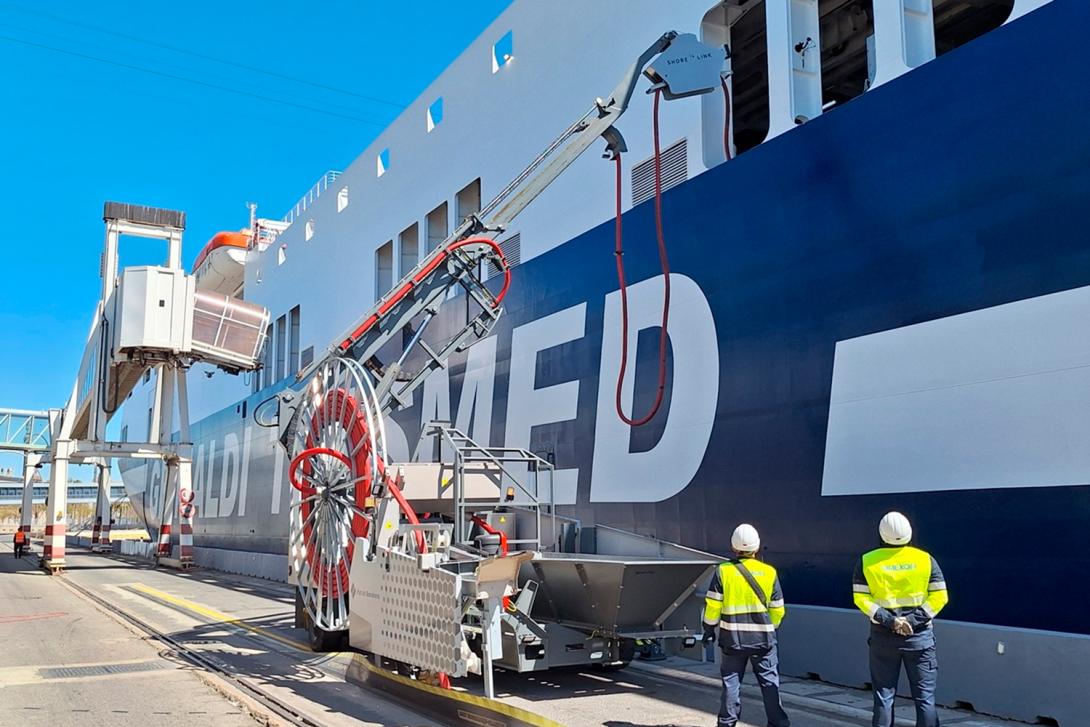The Port of Barcelona officially opens its first OPS for ferries at Grimaldi Terminal Barcelona
The OPS now connects the ferry that plies the Barcelona - Palma route daily, completing the first phase of the Nexigen plan.
The new system will reduce CO2 emissions from ships docking at the Port of Barcelona by 2,090 tonnes per year, substantially improving emissions and noise conditions in nearby neighbourhoods.

The Port of Barcelona's first Onshore Power Supply (OPS) for ferries is now operational at Grimaldi Terminal Barcelona, on Sant Bertran wharf. This OPS supplies 100% renewable electricity daily to the ferries connecting Barcelona with the Balearic Islands, allowing them to turn off their engines, preventing the emissions and noise they generate while at port.
The entry into service of the OPS for ferries completes phase one of the Nexigen plan for wharf electrification, involving an investment of over €200 million, which will make it possible to cut emissions from port activity by 47%. Just like the BEST terminal's OPS, officially opened last summer, which is the first to be installed in a container terminal in a Mediterranean port, the Grimaldi Terminal Barcelona OPS is operating in a pilot phase to provide data and experience regarding supplying electricity to ships.
The OPS was set up in coordination with Grimaldi Logística España, designing its various systems to make them compatible with the daily operations of the terminal. In parallel, Trasmed, the Spanish shipping company of the Grimaldi Group, has adapted its vessels Ciudad de Palma and Ciudad de Sóller to make them compatible with the system, and they now connect and stop their engines during their calls at the Port of Barcelona.
Cutting emissions
The possibility to connect the two ships that cover the Barcelona-Palma line daily will multiply the positive impact of the new system. By stopping their engines during their stay in the Port of Barcelona, these ships will avoid emitting an average of 6.14 tonnes of CO2 per call. This makes 2,090 tonnes of CO2 annually.
The terminal is located close to the city, next to Plaça de les Drassanes and less than 200 metres from the closest houses in Poble-sec district, and this increases the positive impact of the system for residents, improving air quality in Barcelona and reducing the noise generated by ship operations.
The OPS, manufactured by Vinci Energies in France, combines a fixed installation, which adapts the frequency and voltage of the electrical current to the specific needs of each ship, with a mobile system manufactured by Shore Link in Estonia that makes it possible to connect the system without interfering with dock operations. The current system allows a single ship to be connected, but the installation has been designed to be easily expandable so that two ships can be connected simultaneously at the two docking points on Sant Bertran wharf. The system cost €3.5 million and was partly financed through the Sustainable and Digital Transport Support Programme under the Recovery, Transformation and Resilience Plan.
The opening ceremony was attended by the Regional Minister of Territory, Silvia Paneque; the CEO of Grimaldi Logística España, Mario Massarotti; the CEO of Trasmed, Ettore Morace; the Operations Manager of Puertos del Estado, Pedro García, and the president of the Port of Barcelona, José Alberto Carbonell.
“This OPS is especially important because it is located at the terminal that is closest to the city. When we talk about decarbonising port activity, we are thinking about the climate emergency, but above all we are thinking about the quality of life of the people around us. Today is a big step in this direction, but it will not be the last. The Grimaldi Terminal Barcelona OPS allows us to continue moving forward with the Nexigen plan to improve the air quality of our surrounding area and make port activity more sustainable”, said the president of the Port of Barcelona.
For his part, Mario Massarotti, CEO of Grimaldi Logística España, stated that “once again, the Grimaldi Group reaffirms its commitment to sustainable transport. All vessels operating on the Italian market have been equipped with batteries for several years and have been operating with zero emissions in the port since then. This same commitment is shared by Trasmed, the group's company operating in the Balearic market, which has invested over €1.2 million to adapt vessels to the OPS (Onshore Power Supply) system. Thanks to these initiatives, we are proud to be the only group in the Port of Barcelona that operates in this terminal with zero emissions, thus contributing to improving air quality and the well-being of the citizens of Barcelona”.
“We need to understand how difficult it is for large infrastructures to adapt to the energy transition, due to their size and the fact that they involve multiple players,” stated Regional Minister of Territory, Silvia Paneque, adding that “it is important to acknowledge the strategy, effort and involvement of the Port of Barcelona with the development of the Energy Transition Plan that it is rolling out as it moves towards its goal of becoming a carbon-neutral Port by 2050 and a hub for the production and distribution of green energy.”
Pedro García Navarro, Operations Manager at Puertos del Estado, highlighted that “this initiative represents a significant step for the state port system in the process of electrifying wharves. This new step forward at the Port of Barcelona responds to the commitment of the state-owned port system to sustainability and innovation. The installation that is being launched today, resulting from the collaboration of the entire public sector and private initiative, serves as an example for port precincts, transport chains and the Spanish energy transition.”
Phase one of the Nexigen plan
The launch of the Grimaldi Terminal Barcelona OPS is another step in the Nexigen plan to electrify the main wharves of the Port of Barcelona by 2030. In parallel to the entry into service of the two pilot projects, progress is being made building a new electrical substation from which a new medium-voltage network will be deployed throughout the port area, including an underwater pipeline to connect the supplies of the Energy wharf and the Adossat wharf, essential for electrifying the cruise terminals.
The ultimate aim of electrifying the Port of Barcelona wharves is to improve air quality around the port area and is a key part of the Energy Transition Plan, becoming one of the pillars of the decarbonisation of port activity.



